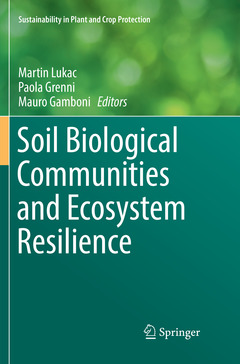Description
Soil Biological Communities and Ecosystem Resilience, 1st ed. 2017
Sustainability in Plant and Crop Protection Series
Language: English
Subjects for Soil Biological Communities and Ecosystem Resilience:
Keywords
Publication date: 08-2018
Support: Print on demand
Publication date: 10-2017
Support: Print on demand
Description
/li>Contents
/li>Comment
/li>
This volume explores current knowledge and methods used to study soil organisms and to attribute their activity to wider ecosystem functions. Biodiversity not only responds to environmental change, but has also been shown to be one of the key drivers of ecosystem function and service delivery. Soil biodiversity in tree-dominated ecosystems is also governed by these principles, the structure of soil biological communities is clearly determined by environmental, as well as spatial, temporal and hierarchical factors. Global environmental change, together with land-use change and ecosystem management by humans, impacts the aboveground structure and composition of tree ecosystems. Due to existing knowledge of the close links between the above- and belowground parts of terrestrial ecosystems, we know that soil biodiversity is also impacted. However, very little is known about the nature of these impacts; effects on the overall level of biodiversity, the magnitude and diversity of functions soil biodiversity generates, but also on the present and future stability of tree ecosystems and soils. Even though much remains to be learned about the relationships between soil biodiversity and tree ecosystem functionality, it is clear that better effort needs to be made to describe and understand key processes which take place in soils and are driven by soil biota.
1 Introduction: the role of soil biodiversity in ecosystem productivity and resilience - Martin Lukac
2 Ecosystem services provided by soil microorganisms - Maria Ludovica Saccá, Anna Barra Caracciolo, Martina Di Lenola and Paola Grenni
3 Comparison of two molecular methods to assess soil microbial diversity - Martina Di Lenola, Paola Grenni, Diogo N. Proença, Paula V. Morais and Anna Barra Caracciolo
4 Towards integrated understanding of the rhizosphere phenomenon as ecological driver: can rhizoculture improve agricultural and forestry systems? -Luis G. García–Montero, Pablo Manzano, Deaa Alwanney, Inmaculada Valverde–Asenjo, Amaya Álvarez-Lafuente, Luis F. Benito–Matías, Xavier Parladé, Sigfredo Ortuño, Marcos Morcillo, Antonio Gascó, Carlos Calderón-Guerrero, Francisco Mauro, Mercedes Méndez, Alvaro Sánchez–Medina, María P. Andrés, José R. Quintana, Cristina Menta, Stefania Pinto, Liliana Pinto, Pilar Pita, Cafer Turkmen, Cristina Pascual, Esperanza Ayuga, Fernando Torrent, José C. Robredo, Pablo Martín–Ortega, Joan Pera, Luis Gómez, Gonzalo Almendros, Carlos Colinas and Eric P. Verrecchia
5 Impact of agricultural land management on soil bacterial community: a case study in the Mediterranean area - Annamaria Bevivino and Claudia Dalmastri
6 A metagenomic study on the effect of aboveground plant cover on soil bacterial diversity - Mariantonietta Colagiero, Isabella Pentimone, Laura Cristina Rosso and Aurelio Ciancio
7 What lies beneath: root-associated bacteria to improve the growth and health of olive trees - David Ruano-Rosa, Antonio Valverde-Corredor, Carmen Gómez- Lama Cabanás, Rafael Sesmero and Jesús Mercado-Blanco
8 Norway spruce fine roots and fungal hyphae grow deeper in forest soils after extended drought - Isabella Børja, Douglas L. Godbold, Jan Světlík, Nina E. Nagy, Roman Gebauer, Josef Urban, Daniel Volařík, Holger Lange, Paal Krokene, Petr Čermák and Toril D. Eldhuset
9 Ectomycorrhizal diversity in beech dominated stands in central Europe - Christoph Rosinger, Hans Sandén and Douglas L. Godbold
10 Arbuscular mycorrhizal fungal communities pushed over the edge – lessons from extreme ecosystems- Irena Maček
11 An intact soil core bioassay for cultivating forest ectomycorrhizal fungal communities - Peter G. Avis, Ina C. Meier and Richard P. Phillips
12 Potential role of beneficial soil microorganisms in plant tolerance to abiotic stress - Raffaella Balestrini, Walter Chitarra, Vasileios Fotopoulos and Michelina Ruocco
13 Microbial communities, functional genes, and nitrogen cycling processes as affected by tree species - Relena R. Ribbons, Morag A. Mcdonald, Lars Vesterdal
14 Ectomycorrhizal fungal responses to forest liming and wood ash addition: review and meta-analysis - Rasmus Kjøller, Carla Cruz-Paredes and Karina E. Clemmensen
15 β-glucosidase activity of forest soil as an indicator of soil carbon accumulation - Ewa Błońska and Jarosław Lasota
16 Linking ecosystem variability and carbon sequestration: estimation of sequestered carbon in natural forests and perennial crops - Jelena Milovanović, Uroš Radojević and Mirjana Šijačić-Nikolić
17 Bioactive peptaibols of forest-derived trichoderma isolates from section Longibrachiatum - Tamás Marik, András Szekeres, Maria A. Andersson, Mirja Salkinoja-Salonen, Chetna Tyagi, Balázs Leitgeb, Csaba Vágvölgyi, Irina S. Druzhinina and László Kredics18 Plant-assisted bioremediation: an ecological approach for recovering multi-contaminated areas - Valeria Ancona, Paola Grenni, Anna Barra Caracciolo, Claudia Campanale, Martina Di Lenola, Ida Rascio, Vito Felice Uricchio and Angelo Massacci
19 Bioavailability of polycyclic aromatic hydrocarbons in soil as affected by microorganisms and plants - Jose Julio Ortega-Calvo, Rosa Posada-Baquero, José Luis Garcia and Manuel Cantos
Illustrates the contribution of belowground biota to the overall stability of an ecosystem, with particular reference to microbial communities
Enriches understanding of the plethora of functions performed by soil organisms and how these can be utilized to maintain delivery of ecosystem services
Covers some of the latest thinking and methodological developments in the study of organisms inhabiting soils in tree dominated ecosystems




